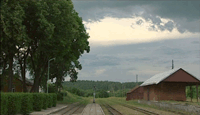 Similar to Boris Lehman’s essay film, À la recherche du lieu de ma naissance, Richard Copans’ Racines examines the nature of identity, migration, transplantation, and reconstructed history. A routine trip to the dentist provides the point of departure for the filmmaker, as they discuss implants as a way of recreating permanent teeth through artificial roots. For Copans, the analogy proves salient. The son of Simon Copans, an American expatriate and Voice of America jazz radio personality (as well as a communist sympathizer who emigrated to France during the Red Scare to avoid political persecution), his knowledge of his paternal family history had been limited to familiar stories of turn of the century immigrants from old Europe coming to America to avoid religious persecution. But retracing the past through the ravages of history soon proves to be a tangled and disconnected tale. Tracing the family surname to millers at a farm in Vilnius that had once been designated as a ghetto for the country’s “stateless cultures” who migrated from other places such as Poland and Russia, Copans is faced with the reality that he may never be able to trace his roots beyond his ancestors’ adopted Lithuanian homeland. Finding a kindred spirit in a Yiddish professor from Brooklyn, New York who relocated to Lithuania in order to study – and in some small way, reclaim – traces of his heritage, Copans hears first hand the indirect legacy of the diaspora: abandoned cemeteries now dependent on the charity of expatriates for their maintenance, younger generations who no longer carry on the traditions of their faith, and splintered families who have lost relatives in their search for a better life (in one episode, an octogenarian named Ziske idiosyncratically parallels his reluctance to leave Lithuania and resettle in Israel with his cousin’s ill-fated passage on the Titanic in pursuit of a better life in America).
Similar to Boris Lehman’s essay film, À la recherche du lieu de ma naissance, Richard Copans’ Racines examines the nature of identity, migration, transplantation, and reconstructed history. A routine trip to the dentist provides the point of departure for the filmmaker, as they discuss implants as a way of recreating permanent teeth through artificial roots. For Copans, the analogy proves salient. The son of Simon Copans, an American expatriate and Voice of America jazz radio personality (as well as a communist sympathizer who emigrated to France during the Red Scare to avoid political persecution), his knowledge of his paternal family history had been limited to familiar stories of turn of the century immigrants from old Europe coming to America to avoid religious persecution. But retracing the past through the ravages of history soon proves to be a tangled and disconnected tale. Tracing the family surname to millers at a farm in Vilnius that had once been designated as a ghetto for the country’s “stateless cultures” who migrated from other places such as Poland and Russia, Copans is faced with the reality that he may never be able to trace his roots beyond his ancestors’ adopted Lithuanian homeland. Finding a kindred spirit in a Yiddish professor from Brooklyn, New York who relocated to Lithuania in order to study – and in some small way, reclaim – traces of his heritage, Copans hears first hand the indirect legacy of the diaspora: abandoned cemeteries now dependent on the charity of expatriates for their maintenance, younger generations who no longer carry on the traditions of their faith, and splintered families who have lost relatives in their search for a better life (in one episode, an octogenarian named Ziske idiosyncratically parallels his reluctance to leave Lithuania and resettle in Israel with his cousin’s ill-fated passage on the Titanic in pursuit of a better life in America).
In an encounter with a Jewish family in Vilnius, a passing dinner conversation about traceable history as a kind of status symbol that is often denied ordinary people unexpectedly recalls an earlier conversation in Copans’s maternal ancestral hometown of Picardy, where an enterprising man has decided to open his grandparents’ home as a preservational museum, arguing that there is an audience interested in a glimpse of their forefathers’ nineteenth century peasant life. In a wry coincidence, Copans’s American cousin, a certified public accountant, keeps a framed picture of a fabricated family crest (claiming a Russian ancestry that the filmmaker was unable to decisively trace) and a collage of store fronts bearing the Copans name in order to impress clients with his many varied “business ventures” (in reality, the reference to Copans was from name of the street and not directly connected with the family). Perhaps the most illuminating point of convergence occurs in Copans’s search through US census logs, assisted by a professional genealogist specializing in African American ancestry who explains that her focus stems from the absence of national archives available before the abolition of slavery in 1865, requiring additional research using ship manifests, plantation owner logs, and property tax assessments to trace distant ancestry. Reconnecting with long-time family friends who share their vivid memories of his grandparents as they immigrated to America to establish a new life, Copans’s earlier reference to his father’s jazz finds a paradoxical sense of arriving at a terminus in his grandparents’ adopted home, where the exhilaration of new cultures transcends the particularity of the immigrant experience and converges towards a human one.
Acquarello, 2009 [reprinted]